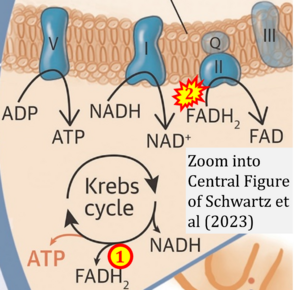Schwartz 2022 JACC Basic Transl Sci
| Schwartz B, Gjini P, Gopal DM, Fetterman JL (2022) Inefficient batteries in heart failure: metabolic bottlenecks disrupting the mitochondrial ecosystem. JACC Basic Transl Sci 7:1161-79. https://doi.org/10.1016/j.jacbts.2022.03.017 |
Schwartz B, Gjini P, Gopal DM, Fetterman JL (2022) JACC Basic Transl Sci
Abstract: Mitochondrial abnormalities have long been described in the setting of cardiomyopathies and heart failure (HF), yet the mechanisms of mitochondrial dysfunction in cardiac pathophysiology remain poorly understood. Many studies have described HF as an energy-deprived state characterized by a decline in adenosine triphosphate production, largely driven by impaired oxidative phosphorylation. However, impairments in oxidative phosphorylation extend beyond a simple decline in adenosine triphosphate production and, in fact, reflect pervasive metabolic aberrations that cannot be fully appreciated from the isolated, often siloed, interrogation of individual aspects of mitochondrial function. With the application of broader and deeper examinations into mitochondrial and metabolic systems, recent data suggest that HF with preserved ejection fraction is likely metabolically disparate from HF with reduced ejection fraction. In our review, we introduce the concept of the mitochondrial ecosystem, comprising intricate systems of metabolic pathways and dynamic changes in mitochondrial networks and subcellular locations. The mitochondrial ecosystem exists in a delicate balance, and perturbations in one component often have a ripple effect, influencing both upstream and downstream cellular pathways with effects enhanced by mitochondrial genetic variation. Expanding and deepening our vantage of the mitochondrial ecosystem in HF is critical to identifying consistent metabolic perturbations to develop therapeutics aimed at preventing and improving outcomes in HF.
• Bioblast editor: Gnaiger E
Correction: FADH2 and Complex II
- FADH2 is shown as the substrate feeding electrons into Complex II (CII). This is wrong and requires correction - for details see Gnaiger (2024).
- Gnaiger E (2024) Complex II ambiguities ― FADH2 in the electron transfer system. J Biol Chem 300:105470. https://doi.org/10.1016/j.jbc.2023.105470 - »Bioblast link«
Labels: Pathology: Cardiovascular
Tissue;cell: Heart


